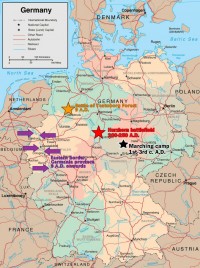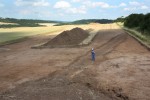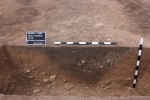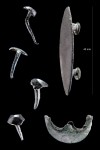 A Roman marching camp from the 1st to 3rd century A.D. has been discovered near the town of Hachelbich in Thuringia. It’s the first Roman military camp found in the eastern German province and the first camp that is more than a day’s travel from the eastern border of the empire on the Rhine. In fact, it’s closer to the Elbe River than it is to the Rhine (the Elbe is about 150 miles east of the site, the Rhine 220 west), a strong indication that the Roman military did not completely withdraw to the Rhine even after three legions led by Publius Quintilius Varus were slaughtered by Germanic tribesmen at the Battle of Teutoburg Forest in 9 A.D.
A Roman marching camp from the 1st to 3rd century A.D. has been discovered near the town of Hachelbich in Thuringia. It’s the first Roman military camp found in the eastern German province and the first camp that is more than a day’s travel from the eastern border of the empire on the Rhine. In fact, it’s closer to the Elbe River than it is to the Rhine (the Elbe is about 150 miles east of the site, the Rhine 220 west), a strong indication that the Roman military did not completely withdraw to the Rhine even after three legions led by Publius Quintilius Varus were slaughtered by Germanic tribesmen at the Battle of Teutoburg Forest in 9 A.D.
 The discovery of a large third century battlefield on Harzhorn hill in Lower Saxony in 2008 confirmed that there was a significant Roman military presence east of the Teutoburg Forest more than 200 years after Varus’ humiliating defeat. Archaeologists estimate about 1,000 Roman soldiers fought (and won) at Harzhorn. The Hachelbich marching camp is about 60 miles southeast of Harzhorn. It covers 18 hectares and was large enough to accommodate an entire legion of around 5,000 soldiers. As a marching camp, it wasn’t a permanent fortress, but rather a protective enclosure built by the legionaries in one evening so they could camp down in a defended position. They wouldn’t have spent more than a few days there while on their way elsewhere, in this case probably east towards the Elbe.
The discovery of a large third century battlefield on Harzhorn hill in Lower Saxony in 2008 confirmed that there was a significant Roman military presence east of the Teutoburg Forest more than 200 years after Varus’ humiliating defeat. Archaeologists estimate about 1,000 Roman soldiers fought (and won) at Harzhorn. The Hachelbich marching camp is about 60 miles southeast of Harzhorn. It covers 18 hectares and was large enough to accommodate an entire legion of around 5,000 soldiers. As a marching camp, it wasn’t a permanent fortress, but rather a protective enclosure built by the legionaries in one evening so they could camp down in a defended position. They wouldn’t have spent more than a few days there while on their way elsewhere, in this case probably east towards the Elbe.
 The site was found in 2010 during road work, but it was kept quiet while archaeologists explored the area. They excavated more than two hectares and covered another 10 hectares with magnetometers and aerial surveys. Now that the site has been identified as a military camp, the Thuringian State Office for Heritage and Archaeology has announced the find. They’re keeping the exact location a secret, however, to keep looters from ravaging the place on the hunt for portable Roman artifacts.
The site was found in 2010 during road work, but it was kept quiet while archaeologists explored the area. They excavated more than two hectares and covered another 10 hectares with magnetometers and aerial surveys. Now that the site has been identified as a military camp, the Thuringian State Office for Heritage and Archaeology has announced the find. They’re keeping the exact location a secret, however, to keep looters from ravaging the place on the hunt for portable Roman artifacts.
A rough rectangle with round corners, the camp is standard Roman military issue. No matter where they were, legions on the move set up a minifortress in the wilderness at the end of each day’s march. At Hachelbich, the meter-deep trenches dug around the camp were the easiest feature to spot in the soil. Two perimeter trenches have been found, each more than 400 meters long.
On the camp’s northern edge, the soldiers built a gate protected by another trench that projected out past the perimeter. “It’s typically Roman—no Germans did that sort of thing,” Kuessner says. The trenches were part of a simple, but effective makeshift perimeter defense: A low wall of dirt was thrown up behind the trench, then topped with tall stakes, to create a defensive barrier almost 3 meters wide and 3 meters high. Erosion wiped away the wall long ago, but it left discolorations in the soil where the trench was dug.
 Archaeologists also unearthed the remains of eight bread ovens close to the camp perimeter, which shows an impressive commitment to quality food considering the legionaries weren’t going to be there for long. Some artifacts confirming the military nature of the camp were found: four hobnails from the soles of Roman caligae, fittings from a sword scabbard and horse tackle.
Archaeologists also unearthed the remains of eight bread ovens close to the camp perimeter, which shows an impressive commitment to quality food considering the legionaries weren’t going to be there for long. Some artifacts confirming the military nature of the camp were found: four hobnails from the soles of Roman caligae, fittings from a sword scabbard and horse tackle.
 The style of the artifacts places the camp in the first two centuries of the first millennium and radiocarbon dating supports the range, but archaeologists haven’t found anything to narrow it down any further or link to the camp to the reign of a certain emperor. Excavations will continue this year and the next at least. After the crops in the valley are harvested this fall, archaeologists will be able to excavate the farmland. They hope to find coins that will provide a precise date, or an artifact with the legion number on it that would write a new chapter in Roman military history.
The style of the artifacts places the camp in the first two centuries of the first millennium and radiocarbon dating supports the range, but archaeologists haven’t found anything to narrow it down any further or link to the camp to the reign of a certain emperor. Excavations will continue this year and the next at least. After the crops in the valley are harvested this fall, archaeologists will be able to excavate the farmland. They hope to find coins that will provide a precise date, or an artifact with the legion number on it that would write a new chapter in Roman military history.
I’m always a little bit baffled about media statements along the line of we all of a sudden find they “did not completely withdraw after (Varus)” and “maintained significant military presence (after Varus)”. We already knew from text sources and the occasional singulary find that the Romans did campaign on occasion into Germania Magna during the centuries after the Varus defeat. This is exactly what sites like Harzhorn and Hachelbich confirm too, and it should come as no surprise to anyone (or, anyone but folklore that likes to assume the Romans spent the rest of their tenure shivering in fear behind the Limes, keeping the gates locked tight and never to set foot again on that dreaded Germanic soil). This is great news as it confirms known sources. Nothing more and nothing less. I mean, it’s not like this is a paradigm shift or anything, so why is it advertised as one by some?
That is definitely an interesting find, and to a certain extent it might indeed be reasonable to assume that the Romans stopped their major ‘trans-rhenish’ activities after Varus had lost his legions in 9 AD. According to Tacitus in 98 AD, Germania is dull place not even worth to ignore.
It would be great to know, if the new excarvations from obviously later expeditions might relate to what is referred to as the ‘Marcommanic Wars’, i.e. the ‘expeditio Germanica prima et secunda’ (170-180 AD) or to the ‘expeditio Burica’, aka the ‘3rd marcomannic war’ (182 AD).
These activities might have been of a more ‘trans-danubian’ character. So whatever might have taken place, there is definitely more than just this isolated makeshift enclosure.
My ancestors come from this area of Thuringia and our genealogy goes back into the 17th century. Interesting that our Y-DNA haplogroup [E-PF4428] has a completely isolated “hotspot” in this area and is thought to have come from the Roman Balkans or Iberia. Our ancestral name “Wiegand” means warrior or soldier.
It sucks that they have to keep it secret but I understand that its necessary. It would be nice if you could just trust people lol. Nice write up.
If you like Roman history check out my blog:
blogusaugustus.com
Hi Gary,
I’m also E-PF4428 (and downstream F42). I’m Brazilian of portuguese ancestry (Rodrigues and Vasconcelos). We might be very very distant cousins, but if you suspected some Iberian genes, there you have it!
Oi Felipe, tudo bem?
Yes, we have connections to Brazil but not through our Y-DNA. My kids are Brazilian citizens through their mother’s family.
please see: http://www.batucadayemanja.4t.com
and: http://www.hunthill.4t.com/index.html
My E-PF4428 theory goes back to the Romans. Hard to explain??
tchao – seu primo nos EUA – Gary
Hi Gary,
This is great! I believe our common ancestor was from northern Portugal/Spain, at least 1000 years ago (maybe even more!). In FTDNA I’m the only F42, so it is nice to hear about someone E-PF4428. Were did you upload your file? I’d love to run a match with it!
Obrigado!
FFR
What is the whole code of this E-PF4428? E1b1b1b2a?
What do you mean by the whole code? Did you upload your DNA anywhere? Perhaps we could match it!
the code is P305>M42>M168>M203>M96>P147>P177>P2>M215>M123 (from genographic)
starting from familytreeDNA
P147>L499>P2>M215>M215>L796>M35>Z827>CTS10298>PF1962>M123>PF4428
Felipe and Valanis
My DNA descent is identical to Valanis’: P305>M42>M168>M203>M96>P147>P177>P2>M215>M123 (from geographic).
E-PF4428
Its the same thing. So are we all some kind of relatives? From where is the origin of your male lines? Mine is from Bulgaria. But my question was about the code E-PF4428 – is it presented in the internet as “E1b1b1b2a1b” or “E1b1b1c” – its a real mess because these code names has changed several times. My info can be found in Geno2.0 and FTdna.
We could be relatives, at least distant ones. From Geno 2.0 everyone around me is Jewish and our clad is known for high incidence in Jewish populations in Iberia. My guess is that long time ago we had a common ancestor from northern Spain/Portugal that left roots there and re-settled in eastern Europe.
Valanis and Gary,
How do I find you guys in FTDNA?
Thanks,
Felipe
I don’t know how to link my profile but if you two can join the E-M35 Project you can find some info there – https://www.familytreedna.com/groups/e-3b/dna-results – just click on the SNPs results and check for E-PF4428. Me and you Felipe are the only ones with 4428. Gary could join too. Ive spoke with the admin of a DNA website and she said that the three of us – me, Felipe and Gary – are the only e-pf4428 that are connected to each other. At least from the info that she found on the internet. She said e-pf4428 is a very rare thing. Are you guys tested further? Are the haplotypes local to Iberia / Germany? I’ll test myself in the near future for further info. For now my theories are gravitating over Neolithic migration from the Near East>Anatolia>Balkans. In the second scenario – Roman colonists.
So it turns out i’m E-M123* which is m123 positive and M34 negative, the oldest version of m123. Are you guys M-123* too? You can find my SNPs on the E-M35 project, I can send you an email if you wish with more info.
Hello, me too I am E-PF4428 (as per genographic 2.0 test). I am originaly from Eastern Europe (Moldova). The more I learn about it, the less it seems to make sens.
The test also shows that I have 70% eastern europe, 9% Western europe, 9% suthern europe, 4% asia minor, 3% arabia, 2% jewish diaspora and 2% eastern asia.
I have no known connections to Spain or Portugal on my father side.
Hello Dimitry,
Glad to see a new person with this haplogroup. Are you in Ftdna so we could compare our STR markers? My line is from Romania and having in mind that you are from Moldova it could mean common ancestor in recent times. Also, do you have a BigY yet? I am the sample on PF4428 branch there (https://www.yfull.com/tree/E-Y31991/ ) – if you do a bigY you will be on my branch and it could estimate the time to our potential common ancestor. Our results bare no relation to Portugal but they are spilled all over Europe here and there with no recent connection between them. It means that Pf4428 is very old. So far PF4428 is found in Romania, Moldova, Germany, Austria, England, Italy, Portugal and also in Lebanon, Qatar, Tunisia and Armenia. Last month our haplogroup was found in Iron Age remains from central Asian Scythians which comes to show that is really old and that is really hard to assign it to any tribe from the past.
About your autosomal results – they are unrelated to your haplogroup and seems more or less normal for Moldova – you have high Slavic influence, possibly Ukrainian connection? The South Euro+Asia Minor+Arabia is equal to the local Thracian elements; also minor Steppe influence.
This is my email – valanius@abv.bg
Hello, I was tested positive for E-M123 and predicted by MorleyDNA to be PF4428 F42. Felipe is a match of mine in FTDNA, as are a few other individuals of Iberian descent (and one Norwegian), and we share the same family name.
I am also on the E-M35 FTDNA project, you can see my location on the project map
My ancestry is from north-central Portugal (rural areas near Viseu) since at least the 1800s, I haven’t investigted before, but considering it’s a poor rural area it’s not very likely it arrived there in recent times
Thüringia Hapogroup e
https://youtu.be/-nEpXt3qyYA
https://youtu.be/37c-WFuel2k